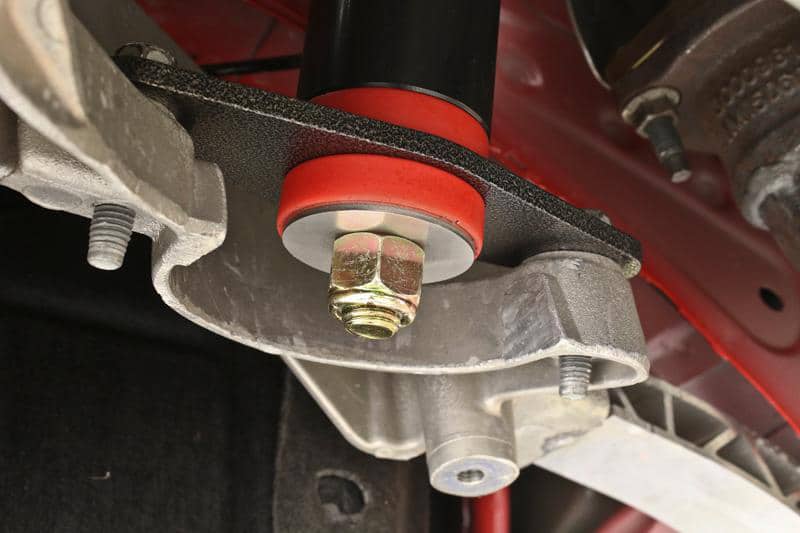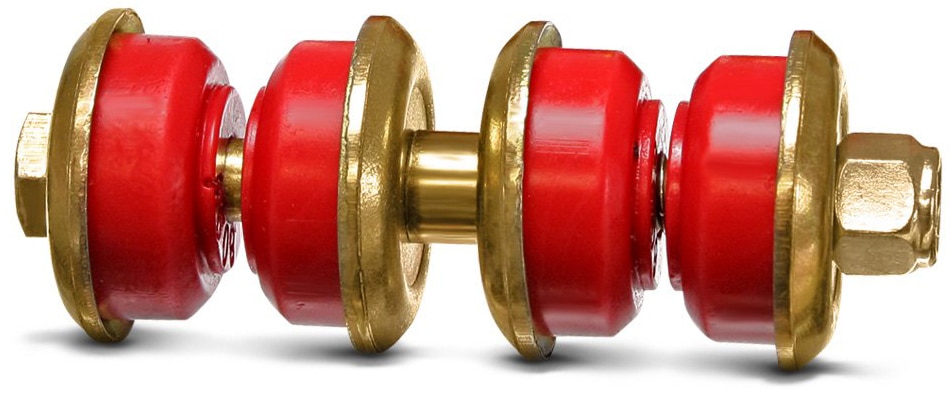Bushings are simple and seemingly insignificant components that make a world of difference in terms of ride quality, NVH levels, and road feel.
They’re essentially an intermediary between metal parts that stay stationary and those that move.
Bonded rubber and polyurethane are ideal materials for this use case, owing to their mechanical properties and suitability for applications that require vibration damping.
In this article, we’ll discuss the differences between rubber and polyurethane bushings and compare their mechanical properties.
What Are Bushings for?
Suspension bushings are consumable components that require occasional replacement.
They’re constructed using shock-absorbent elastomers — typically polyurethane and rubber — housed within an outer metal sleeve with enough room to accommodate an inner sleeve.
Their main objective is to prevent metal-to-metal contact and facilitate movement between moving and stationary metal parts without friction.
For instance, suspension control arms are responsible for controlling the verticle, side-to-side, and fore-aft movement of the wheels. They’re able to do this by linking the chassis (stationary metal part) to the steering knuckles (moving metal part).

Obviously, the link between the two can’t have metal-on-metal contact, because that would make for terrible ride quality. That’s why automakers use elastomer bushings to isolate the vibrations from the wheels to the chassis.
Bushings are used for practically every metal-on-metal pivot point in the car; they’re not exclusive to the suspension system. Some examples include:
- Limited slip differential mounts
- Control arms
- Motor mounts
- Transmission mounts
- Sway bars
- Ball joints
- Strut mounts
- Coilovers
- Chassis mounts
- Subframe mounts
Telltale Signs of Worn-Out Suspension Bushings

Bushings are able to do what they do because of the relative motion between the elastomer and the outer sleeve. This motion occurs due to deflection (not slippage) between the two.
This relative motion is why bushings have that much-needed “give” which effectively translates to overall smoothness. The elastomer material in the bushing can only stretch so far before failure.

How long your bushings will last depends on the material they use, whether they were installed correctly, and your driving style. Unlike maintenance items such as oil and fluid replacement, there’s no fixed interval for bushing replacement.
Most mechanics suggest replacing your suspension bushings if you start to notice symptoms such as:
- Less responsive and unstable steering at high speeds or under braking.
- Pronounced road noise and vibrations.
- Clunking sounds and rattling when driving over rough patches. This can also happen if you have clunking coilovers.
- Sudden deterioration in braking efficiency.
- Worn-out bushings will affect your steering and suspension geometry, making them unable to maintain accurate toe angles during braking and acceleration. This leads to uneven tire wear.
Polyurethane vs Rubber Bushings

Rubber and polyurethane are the most commonly used elastomers when it comes to making suspension bushings, chassis mounts, and motor mounts. If you want to know the symptoms of bad motor mounts, check out our article on the subject.
Even though both elastomers do the same job, they do it very differently owing to the differences in their mechanical properties.
Polyurethane bushings, or poly bushings as they’re colloquially called, are stiffer and more resistant to wear in contrast to rubber bushings. They’re far more resistant to extreme temperatures and don’t require maintenance.
Rubber bushings, on the other hand, are more flexible and have a higher propensity for vibration damping, making them the best material for bushings in passenger cars.
Here are some more features and characteristics of both materials.
Polyurethane

Compared to rubber, polyurethane is much firmer, has a higher tensile strength, and has low levels of elongation. This means it will transfer more noise and vibration to the cabin, which is not ideal for most street-driven cars.
On the flip side, poly bushings provide a much better road feel which significantly improves suspension and steering feedback.
If you want to dial that up a notch, consider comparing Delrin bushings vs polyurethane ones. Delrin bushings boast higher tensile strength, elongation, and chemical resistance in comparison to polyurethane.
The bind-free and low-deflection nature of poly bushings is something most enthusiasts would appreciate; it makes the suspension system a lot more efficient. However, it might be a dealbreaker for those looking for a more comfortable ride.

Because they’re firmer and harder than rubber bushings, they’re able to withstand a lot more abuse from the suspension. They’re also resistant to UV, oils, rust, and extreme temperatures.
With proper care, it’s not uncommon for poly bushings to outlast the car they’re installed on, which is another reason why they’re used in different types of race cars.
They’re not entirely maintenance-free; every few years they’ll need to be re-greased otherwise they will squeak, bind, and wear out. Some poly bushings have grease fittings, others need to be removed in order to perform maintenance.
Ease of disassembly and reinstallation depends on the design of the bushing. Some feature a multi-piece design which makes them very user-friendly, while others require a hydraulic press.
Rubber

Most production cars are fitted with rubber bushings from the factory; it’s not really a performance upgrade. Anyone looking to buy rubber bushings is probably wanting to replace the bushings that their car originally came with.
Rubber is a lot more pliable and softer than polyurethane. As a result, it does a much better job of isolating road noise and vibrations from the cabin, making for a much smoother ride.
The only issue with rubber bushings is longevity. When you compare something like Delrin, a thermoplastic polyurethane vs rubber, don’t be surprised to see that rubber wears out much quicker.

Rubber bushings have a short lifespan since they’re prone to damage from UV, heat, road chemicals, and oil. However, one good thing about rubber bushings is that, unlike poly bushings, they never squeak.
This is because rubber bushings are chemically bonded with their outer shells, so there’s no room for slippage, which furthers their promise of comfort and low NVH levels.
Another advantage is that rubber bushings are virtually maintenance-free. Aside from replacement, there’s nothing much you can do to improve the performance of rubber bushings.
Conclusion: Are Polyurethane Bushings Worth It?

When it comes to choosing the best material for bushings, it’s entirely a matter of horses for courses. You don’t have to use the same material for each bushing in your car, feel free to mix it up.
For the chassis, you might want to choose between silicone vs polyurethane body mounts. Rubber bushings are generally recommended for motor mounts, and for suspension bushings, it comes down to your car and driving style.
Poly bushings are all the rage when it comes to tuner cars, drift cars, and pretty much any discipline of grip racing. But that doesn’t mean that rubber bushings don’t have a place in competitive driving.

Owners of overlanding rigs, especially solid axle rock crawlers, prefer rubber bushings despite their shortcomings. That’s because the pros significantly outweigh the cons for this particular application.
Rock crawlers need all the wheel articulation and flex they can get. For that, rubber bushings are ideal, even though they’re not impervious to oils, petroleum, grime, and dirt.
In contrast, poly bushings are resistant to abrasive material and they can handle axial loads effortlessly, but they have little to no give.
For daily driven trucks and SUVs that see occasional trail time, both rubber and poly bushings are suitable. Rubber bushings will give you more comfort and poly bushings will be more durable.
But for street and track applications, we prefer poly bushings. If your car is nothing more than a fun daily driver, stick to rubber bushings. But if you want all the feedback you can get, then poly bushings are the right choice.

Last but not least, choosing the right Duro rating is super important — this is a metric that measures the firmness of any polymer or elastomer. In the case of both rubber and polyurethane bushings, it’s possible to have the same duro rating for each.
So be sure to choose the right Duro for your application.
What has your experience been like with poly bushings? Do you think they’re worth it? Let us know by leaving a comment below!
If you find this post useful, share it with your friends on Reddit, Facebook, and your favorite car forums. We appreciate your support!

